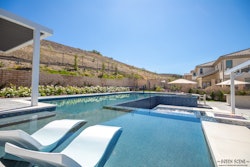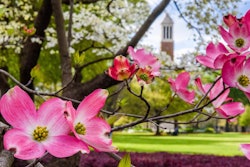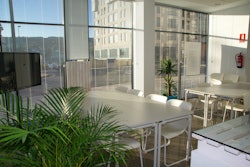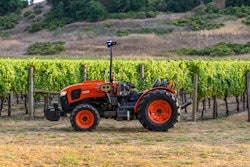 According to the Alabama Historical Association, Marr’s Spring served as a major factor in the selection of Tuscaloosa as the site of UA’s campus in 1827. Photo: Beth Hyatt
According to the Alabama Historical Association, Marr’s Spring served as a major factor in the selection of Tuscaloosa as the site of UA’s campus in 1827. Photo: Beth HyattThis is part two in a two-part series. To read part one, click here.
Campus beautification: Notable areas
While some universities may not consider campus beautification a high priority, retired Colonel Duane Lamb, associate vice president of Facilities and Grounds at the University of Alabama, and his crew insists that it is one of the most important aspects of working on a college campus.
 Photo: Beth Hyatt
Photo: Beth Hyatt“We have found at the University of Alabama, the beauty of our campus is a critical component to the recruitment and retention of the highest quality of students, faculty, and staff,” said Lamb. “We place a high priority on campus beauty and take our job very seriously.”
According to a study performed by Dr. Phillip Waite, a professor and landscape architect with Washington State, 62 percent of high school students make their college choice based on the appearance of the campus buildings and landscape.
“Studies show that students make up their mind in the first 20 minutes before they ever go into a building or meet a professor,” said Donna McCray, senior director of Facilities and Grounds. “And mothers love it. And when mothers are happy, then they feel like their children are safe; they just like the feel.”
In 2015, 2016 and 2017, McCray says the university was rated by Sightlines as No. 1 amongst peers and other schools in the Southeastern Conference (SEC) for having the most beautiful campus.
The Walk of Champions
 Walk of Champions
Walk of ChampionsPhoto: Beth Hyatt
It’s no secret that the University of Alabama is known far and wide for its battle cry, “Roll Tide,” which goes hand-in-hand with their famous football games.
When visiting the campus for such an event, it’s typical that fans will frequent the Walk of Champions at Bryant Denny Stadium, which features statues of Alabama’s head football coaches throughout the years. The most visited one, you may have guessed, belongs to none other than current head coach Nick Saban.
Surrounding the statues is an area covered in sod connecting to a concrete pathway, but in the near future, McCray says pavers will be installed to replace the concrete and sod. This, she says, will make the area more aesthetically pleasing and will save the university time and money by not having to replace the sod as often as they currently do.
Since this area is a high-priority area, McCray says it is maintained once a week from March to October, and in the winter, it’s cared for every two or so weeks.
“Fans and guests make this one of the most popular photographed areas on campus,” said Lamb. “Therefore, we are completing a paver project this summer around each statue to replace the turf. That should be complete for the 2018-19 football season. This will enable the area to remain pristine and available for photos year-round.”
 Many of the oaks lining this portion of campus were planted in memory of World War I veterans from Tuscaloosa who were killed in action.
Many of the oaks lining this portion of campus were planted in memory of World War I veterans from Tuscaloosa who were killed in action.Photo: Beth Hyatt
University Boulevard, Denny Chimes, the President’s Mansion and more
When turning onto University Boulevard, it’s hard not to notice the perfect line of trees adorning each side of the road. Many of the oaks lining this portion of campus, according to McCray, were planted in memory of World War I veterans from Tuscaloosa who were killed in action. Most of the trees, she adds, were planted in the 1920s and are still thriving today.
One of the most popular areas on campus is the main quad, which is home to the Denny Chimes. Named after UA’s former president George H. Denny, this bell tower beckons to students with its frequent ringing and also adds a great focal point to the expansive area.
“Our main quad has been named one of the most beautiful and iconic college quads in America, and I agree 100 percent,” said Lamb. “From our Denny Chimes obelisk structure with its bells in the crown, which can be heard all over campus, to the quad’s beautiful turf and majestic trees, it definitely sets the ‘Southern charm’ tone on our campus.”
Adjacent to Denny Chimes is the President’s Mansion, which boasts a diverse collection of roses. When traveling on foot, it may be difficult at first to see the illustrious rose garden tucked away behind the mansion, but upon closer inspection, it can be found nestled amongst a bed of soft ryegrass, striking pavers and a welcoming cottage.
“The goal is to keep this part of campus looking like this all of the time as a recruiting tool,” said Bryant Anderson, director of landscape and grounds.
 Photo: Beth Hyatt
Photo: Beth HyattWhen it comes to keeping the quad looking top-notch, Lamb says there are several ways he and his crew maintain turf health. The first step, he says, is to select optimum turf for the area, which means taking into account the amount of foot traffic that will occur, as well as what other activities will take place in the area. After this choice is made, Lamb says his crew ensures that four major ingredients are provided to help promote the fullest turf density and color: healthy soil, water, sunlight and oxygen.
 Photo: Beth Hyatt
Photo: Beth Hyatt“With nearly 38,000 students on campus, we do try to control foot-traffic by designing optimal sidewalks where most needed,” Lamb said. “In many other areas, foot-traffic is controlled by placement of shrubs and hedges, in addition to very attractive bollards and chains, which help guide pedestrians in the desired directions.”
Lamb notes that after the football season has come to a close, it is also often necessary to re-seed and aerate areas that have seen an abundance of foot traffic.
While there are many areas Lamb favors on UA’s campus, one of his personal favorites is Marr’s Spring.
“Our entire UA campus is truly beautiful, so I really have many favorite areas,” said Lamb. “(But) from a true ‘green space,’ I would say our renovation of Marr’s Spring, with its beautiful cisterns, azaleas, ferns, magnolias, pines and its English Shrewley bridge, is unquestionably one of my favorite campus areas.”
According to the Alabama Historical Association, this area of campus served as a major factor in the selection of Tuscaloosa as the site of UA’s campus in 1827.
The topiary, campus tree life and other projects
A few years ago, the university’s mascot was brought to life in the form of a bull elephant topiary. Weighing nearly 2,000 pounds, standing 10 feet tall, 14 feet long and 5 feet wide, this campus addition has certainly proven to be a unique focal point for UA.
 Weighing nearly 2,000 pounds, standing 10 feet tall, 14 feet long and 5 feet wide, this campus addition has certainly proven to be a unique focal point for the University of Alabama. Photo: University of Alabama.
Weighing nearly 2,000 pounds, standing 10 feet tall, 14 feet long and 5 feet wide, this campus addition has certainly proven to be a unique focal point for the University of Alabama. Photo: University of Alabama.Photo: University of Alabama
“I think my favorite thing is that it looks like a real animal but a beautiful plant all in one,” Lamb told the Tuscaloosa News. “We tried to make it look as realistic as possible but still a beautiful plant structure.”
After the university president approached Lamb about the possibility of creating an elephant topiary, Lamb traveled to Disney World in Orlando, Florida, to go behind the scenes and understand how they create their character topiaries.
After returning home, Lamb said a team of 30 people from the university’s landscape architecture division, building maintenance, welders, ground department, paint shop, irrigation crews, horticulture, and art department began work on the topiary. Lamb says the process took about two months to complete.
Art department senior sculptors designed the topiary based on photos of bull elephants, then three-quarter-inch steel rods were welded together to make the frame. The netting was then packed with moss about five inches thick and creeping fig was plugged into the moss. Lamb says there are about 3,000 plugs and four zones of irrigation on the inside of the topiary. Both tusks are made of melted aluminum and the eyes are made of 2-inch marbles, painted to look like the eyes of a real elephant.
The topiary is mobile and can be moved to different locations across campus for functions and is displayed during home games.
No college campus is complete without an assortment of trees to adorn the grounds, and UA is no exception. With over 10,000 trees on campus, Anderson estimates the canopy coverage to encompass almost one-third in totality.
Comprised of more than 50 different types of trees, Anderson says that oaks and magnolias are the most prevalent trees across campus. But the rarest, by far, is the single Chinese pistache tree, which was a gift from the queen of England in the mid-1800s.
 Photo: Beth Hyatt
Photo: Beth HyattMcCray notes that recently, the university also had the opportunity to transplant approximately 128 mature crape myrtle trees from a state highway construction project that were going to be taken down. These trees can be found all across the campus and have been thriving since the transplant, according to McCray.
“The trees were going to be destroyed in the midst of a major highway project, so we obtained permission to transplant them to safe locations on our campus,” said Lamb. “It was a very rewarding and sustainable project to save these beautiful trees.”
McCray adds that the campus also works diligently to uphold the five standards set by Tree Campus USA/Arbor Day Foundation of which UA is a member.
The five standards are as follows:
- Must have a campus tree advisory committee.
- Must have a campus tree care plan.
- Must have a campus tree program with dedicated annual expenditures.
- Must observe Arbor Day.
- Must service a learning project.
“Being (part of) Tree Campus USA means we are helping sustain the mission of the university by creating a beautiful place for anybody to come,” McCray told the Tuscaloosa News.
According to Anderson, a team of six people manages the trees, including a professional forester.
“A lot goes into maintaining our trees,” McCray told the Tuscaloosa News. “This is why we have a campus policy that doesn’t permit slacklining, zip lining, hammocks, climbing or nailing anything to our trees. That creates holes in them for bugs to enter and cause disease.”
Future of the green industry
It’s been noted time and time again by green industry professionals, but one of the biggest challenges they face in this particular line of work is facing the stereotypical idea that landscaping only means mowing lawns.
It is true that mowing lawns is a crucial element to this line of work, but it is only a small portion of a much larger scale. Unfortunately, this stereotype can sometimes be a contributing factor to the low student interest in the fields of landscaping, landscape architecture, horticulture, landscaping design and more.
Lamb agrees that he has seen this stigma ring true for many companies and campuses, though he hates to admit it.
 Named after UA’s former president George H. Denny, this bell tower beckons to students with its frequent ringing and also adds a great focal point to the expansive area.
Named after UA’s former president George H. Denny, this bell tower beckons to students with its frequent ringing and also adds a great focal point to the expansive area.Photo: Beth Hyatt
“If you don’t emphasize and train proper mowing techniques, weed control, edging, mulching, tree care, deep root fertilization, pruning techniques, etc., it will not get done properly, and the results will be less than impressive,” said Lamb. “As a leader, it is paramount that you and your team leadership ‘inspect what you expect.’ In other words, get out from behind the desk and see if your crews are doing the job correctly and professionally.”
When asked what he believed industry professionals could do to help raise awareness of this industry, Lamb says the best way to start is to lead from the front, do what needs to be done without taking any shortcuts and to do each landscape project correctly the first time.
Lamb also emphasizes the importance of training grounds, trees, irrigation, etc. crews on the proper techniques they will need to accomplish their jobs, giving them the correct equipment to complete their tasks and ensuring crew members understand the importance of safeguarding their job sites.
His final piece of advice was, whenever possible, give presentations, write articles or participate in interviews with other professional outlets in the green industry to help spread the word.
Currently, the University of Alabama does not offer horticulture or landscaping degree programs, but Lamb does say that students interested in these fields of study are encouraged to interact with the professionals on staff who do have experience with these degrees.
Looking to the future
 Photo: Beth Hyatt
Photo: Beth HyattWhen it comes to preparing for the future of the university, Lamb and his crew already have a few ideas of what they would like to do to improve upon what’s already on campus, as well as a few ideas about what could potentially come to campus one day.
Lamb says he and his department currently have several goals for the landscaping across campus. For starters, Lamb says his department has updated the strategic plan for the university’s landscape and grounds. This plan, he says, serves as the guide for all of their landscape processes, training and procedures. To allow all of UA’s landscape components the opportunity to thrive, Lamb says they will closely adhere to this plan.
He explains that another goal for his team is to provide the grounds and landscape crews with the best possible training and equipment to help them on their road to success.
“Our overall goal is to be one of the most beautiful college campuses in the nation, and to achieve the designation of Tree Campus USA each year,” said Lamb. “We’ve been very successful at achieving these goals for the last several years.”











